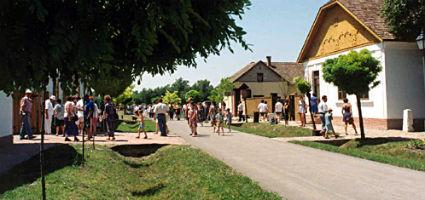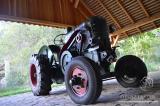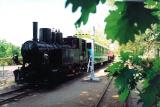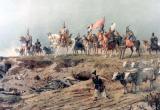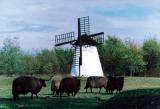|
|
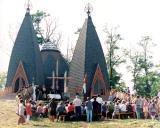
The ten pavilions of the tempoaray exhibition of the temple of forest and nature is opposite to the ecomenic chapel with two towers made of planks of pine. Its silence gives an opportunity to the guests to meditate or to pray.

|
The village hall was the headquarters of the delegates and leadership. Usually it was built in the middle of the village, close to the church. The village hall of Tömörkény built in 1895-96 was moved over to the open air collection. The eclectic building was partly built in the Classicist style characteristic at the end of the 19th century. By this building, the skanzen has a more county town quality.

|
In the neighbourhood of the exhibition titled 'Forest as the temple of nature' a yurt stands. The visitors may see an extremely interesting exhibiton in the pavilion where two thousands years of the history of the Hungarians and nature is overviewed.

|
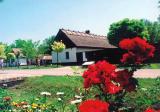
Until the last decades, fishing was very important in the life of the town. The anglers lived in an area called 'inner town'. The sailors of the Tisza, ship builders, and the construction laborers who owned no land or only a small vineyard also lived there.

|
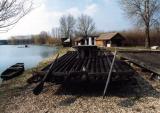
The valley of the river Tisza is a real wild water country. Despite of this, or for this, it was populated in the ancient times as well as the period of the original settlement. The colonies were mainly organized around the flood free areas. Still, the people living there had to protect themselves against water which is why they built embankments.

|
|
|
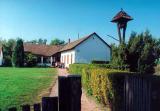
The first attempts to school the children living in the fringes of the South of the Great Planes took place in the 1840's. First, the journeymen and the soldiers thought the kids to read and count in a room of a homestead.

|
Makó became known of its onion both in Hungary and abroad. For the peasants of the county town onion production meant the only way of raising their social standard. It was true especially for the end of the 19th century.

|
|
|
|
|

The exhibition presenting the flora and fauna of the biggest conservation area of Csongrád County is located in the office of Pirtó. The research of the conservation area began 100 years ago.

|
The historic statue pantenon was raised in 2001 around the square in front of the Árpád satute for the 1000th anniveasray of the organization of the Hungarian state.

|
|
|
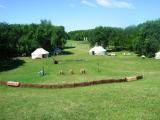
On the site beside the horse court we set out to represent the history of the races of the Euro-Asian plains, and all this through archeological relics and ethnographic parallels. Before the Hungarian settlement Huns were one of the nomadic peoples of the region, who changed their life-style in the 10-11th centuries. This change could first of all be put down to the special geographic advantages of the Carpathian Basin.

|
The year 1896 is not only the time of the birth of the Feszty-Cyclorama but also the time of the heydays of the Austro-Hungarian Monarchy. This was the period when the development of the Hungarian economy was extremely spectacular. The 'promenade' was the walk of the towns of the time. The social life, the holidays, and the weekdays were spent there. Business relationships, social life, and entertainment found their way of expression on the walks.

|
In the outskirts of Hódmezővásárhely 66 reading groups functioned at the beginning of the 20th century. The reading Association of Pusztafeketehalom founded in December 1890 was one of these. The aim of the foundation of the reading groups of the homesteads was to provide a chance and possibility to those living far from the towns to enjoy and at the same time cultivate themselves.

|
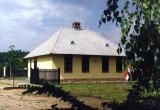
The local railways enmeshed the area of the Great Plane in 1890 but there was non in the area between Tisza and the Danube. To fill this deficiency the minister of transport initiated the building of roads in 1893. Three roads were built. One of them was the 301 kms long road of Baja-Félegyháza-Csongrád- Békéscsaba-Erdőhegy.

|
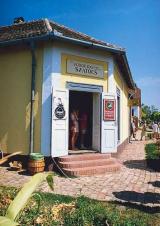
The small shops and the bakeries were necessary part of the people of the villages and county towns. They were also important part of the sight of the settlements. The building in the collection originally was a peasant house of Tápé. In the 1910's a Jewish family bought it and converted the room facing the street into a grocery.

|
Among the towns of the beginning of the 20th century, Szeged had the largest population living in homesteads surrounding the town. In 1930 over 45 000 people lived in 10 000 homesteads of 10-15 acres around Szeged. The homestead we present at our exhibition, the placement and characteristics of the buildings was significant at the turn of the 19-20th centuries. The premises of the house followed the room-kitchen-room-chamber order.

|
According to a tradesman, Szeged was placed on the map in because of its paprika. The paprika originated in Middle America. In Hungary it became acclimatized in the second half of the 16th century, but was used as a grocery only in the second half of the 19th century. Professionalism, diligence, and the conjecture made the paprika producers the most bourgeois layer of society in Szeged.

|
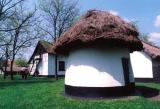
Szentes was a county town at the beginning of the 20th century. In 1930, more than one third of its population lived in homestead. The homesteads of Szentes were open-air type farming estates.

|
|
|
The exhibition is organized in ten pavilions made of pine. The display in the pavilions present the relationship between men and forest (wood).

|
|
|
The exhibition based on the rich findings and the models of buildings presents several centuries starting with the life of the Hungarians of the original settlement and ending with the destruction of the county town of Szer in 1956. Off course, we concentrate at the area of the monastery.

|
The monastery of the Benedictines with the church attached to it was one of the most significant buildings of Hungary in the Middle Ages. The rulers of the world, the members of the Bór-Kalán clan, bare important offices at the royal court and the temple. The monastery was destroyed at the time of the Turkish expansion, but the ruins of the church still stood in the 19th century.

|
|
|
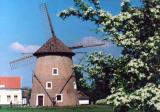
The first windmill was built in the first half of the 18th century in Hungary. The Holland type windmill spread around the 1790-1800 in Hungary. Most of them were situated in the Great Planes and between the Duna and Tisza.

|
|
|
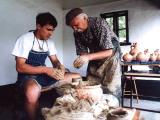
The cartwright worked in the back part of the building. This trade was closely connected to the smiths since they worked together on making a coach or cart. Next to these two shops full of tools of saddlers and harness are displayed. An oil canvas, which was the sign of a master of Szeged 90-100 years ago, is also shown.

|
